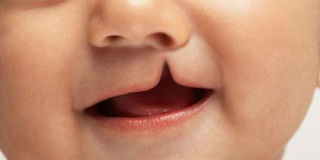Have that cleft lip and palate corrected

Cleft lip as a congenital abnormality that affects an infant’s upper lip and the roof
of the mouth, causing a split lip. Internet PHOTO
Brenda had endured ridicule from almost everyone who saw her.
“My cleft did not affect my speech much but I still went through a lot of stigma at school. I was isolated, insulted and there was nothing I could do about it,” she says
She lived with it till 18-years of age when she met Dr Rose Alenyo, a plastic surgeon consultant at Mulago hospital at a fuel station as she was refilling her car. Dr Alenyo suggested a corrective operation.
“When I told my parents, they seemed skeptical but later gave me a go-ahead. The pain subsided after two weeks, and my lip was completely healed. One cannot even believe that I once had a cleft lip,” she shares.
History repeats itself
Brenda’s agony came back when her child was born with the same problem. Not wanting her child to go through the same trauma she had, she sought help immediately.
“I was referred to Dr Alenyo again and after confirming that my baby had a cleft lip and palate, she was operated and she is now okay, at two years and 10 months.” She says.
Dr Alenyo describes cleft lip as a congenital abnormality that affects an infant’s upper lip and the roof of the mouth, causing a split lip. The lips are formed in a way that the lower segment of the lip comes as a one block, which explains why the cleft happens only to the upper lip, while the upper segment forms in two blocks before joining each other and a slight delay in the joining leads to the cleft, or worse, a palate.
There are a number of cleft lip causes
Genetics
Dr Alenyo says in most cases, if a family has had cases of cleft lip and palate, a child born to that family is likely to inherit it too. This occurs during early stages of pregnancy.
Nutritional
Micro nutrients in early stages of pregnancy are vital for lower chances of producing babies with abnormalities.
This can be corrected by consuming folate, three months before the pregnancy to increase the micro nutrients.
Infections
Infections during the early stages of pregnancy may render the child vulnerable to abnormalities.
Alcohol consumption
Alcoholic mothers are at a higher risk of producing babies with abnormalities and smaller in size and weight says Dr Alenyo.
Symptoms
Children with a palate tend to suffer severe malnutrition due to poor digestion of food. This is because all the food swallowed goes through the airway instead of the esophagus leading to recurrent pneumonia, and a potbelly. A five-months-old baby can weigh about 1.6kg which should not be the case.
Effects
A cleft lip completely deforms a child’s appearance. A palate continues to the roof of the mouth and it might not be seen until a child is supposed to start talking but fails.
This is because the muscle that we use for speaking goes through the roof of the mouth and if the muscle did not join in the middle, there is no way that child can speak.
A palate can at times lead to recurrent ear infections which may lead to deafness. The diaphragm of the ear gets impaired as secretions of food keep blocking the Eustachian tube (the canal that connects the middle ear to the nasopharynx, which consists of the upper throat and the back of the nasal cavity)
Interventions
Doctors at Mulago hospital in partnership with Smile Train, an international children’s charity that supports free cleft repair surgery and comprehensive cleft care for children usually carry out free ciorrective surgeries. This week, these surgeries will be conducted at Mulago Hospital. Both Brenda and her child benefitted from these free surgeries.
Dr Alenyo says t it is way better to treat this at a tender age than later.
*Brenda is not the girl’s real name




